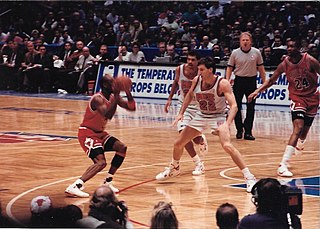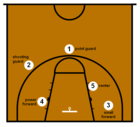
Basketball is a team sport in which two teams, most commonly of five players each, opposing one another on a rectangular court, compete with the primary objective of shooting a basketball through the defender's hoop, while preventing the opposing team from shooting through their own hoop. A field goal is worth two points, unless made from behind the three-point line, when it is worth three. After a foul, timed play stops and the player fouled or designated to shoot a technical foul is given one, two or three one-point free throws. The team with the most points at the end of the game wins, but if regulation play expires with the score tied, an additional period of play (overtime) is mandated.
Strategy is a major part of American football.
A formation in American football refers to the position players line up in before the start of a down. There are both offensive and defensive formations and there are many formations in both categories. Sometimes, formations are referred to as packages.
Zone defense is a type of defense, used in team sports, which is the alternative to man-to-man defense; instead of each player guarding a corresponding player on the other team, each defensive player is given an area to cover.

This glossary of basketball terms is a list of definitions of terms used in the game of basketball. Like any other major sport, basketball features its own extensive vocabulary of unique words and phrases used by players, coaches, sports journalists, commentators, and fans.
A full-court press is a basketball term for a defensive style in which the defense applies pressure to the offensive team the entire length of the court before and after the inbound pass. Pressure may be applied man-to-man, or via a zone press using a zone defense. Some presses attempt to deny the initial inbounds pass and trap ball handlers either in the backcourt or at midcourt.
The following terms are used in water polo. Rules below reflect the latest FINA Water Polo Rules.

The triple option is an American football play used to offer six ways to move the football forward on the field of play. The triple option is based on the option run, but uses three players who might run with the ball instead of the two used in a standard option run.
Basketball coaching is the act of directing and strategizing the behavior of a basketball team or individual basketball player. Basketball coaching typically encompasses the improvement of individual and team offensive and defensive skills, as well as overall physical conditioning. Coaches also have the responsibility to improve their team by player development, strategy, and in-game management. Coaches also teach and inspire their team to be their best.

Zone coverage is a defense scheme in gridiron football used to protect against the pass.
The game of lacrosse is played using a combination of offensive and defensive strategies. Offensively, the objective of the game is to score by shooting the ball into an opponent's goal, using the lacrosse stick to catch, carry, and pass the ball. Defensively, the objective is to keep the opposing team from scoring and to dispossess them of the ball through the use of stick checking and body contact or positioning.
The following terms are used in American football, both conventional and indoor. Some of these terms are also in use in Canadian football; for a list of terms unique to that code, see Glossary of Canadian football.

The 1–3–1 defense and offense is a popular strategy used in basketball.

The 2–3 zone defense is a defensive strategy used in basketball as an alternative to man-to-man defense. It is referred to as the 2–3 because of its formation on the court, which consists of two players at the front of the defense and three players behind.
Line defense is a strategy used in basketball. It is referred to as the "line defense" because of its formation on the court, which consists of two lines of defense. Three players at the front of the defense and two players behind. The line was the first zone concept to be used in basketball. The line defense was developed to counter the fast break plays that were being developed, and adopted, at the time. The line defense was the catalyst of the future 3-2 zone defense.
The amoeba defense is a defensive strategy in the game of basketball.
Basketball is a ball game and team sport in which two teams of five players try to score points by throwing or "shooting" a ball through the top of a basketball hoop while following a set of rules. Since being developed by James Naismith as a non-contact game that almost anyone can play, basketball has undergone many different rule variations, eventually evolving into the NBA-style game known today. Basketball is one of the most popular and widely viewed sports in the world.
Wheel offense is an offensive strategy in basketball, developed in the late 1950s by Garland F. Pinholster at the Oglethorpe University. It is a kind of continuity offense in which players move around in a circular pattern to create good scoring opportunities. The wheel offense is a popular offensive play, frequently used by teams from middle school to college levels because it can effectively work against any defense, including zone defense and man-to-man defense.
A play calling system in American football is the specific language and methods used to call offensive plays.







